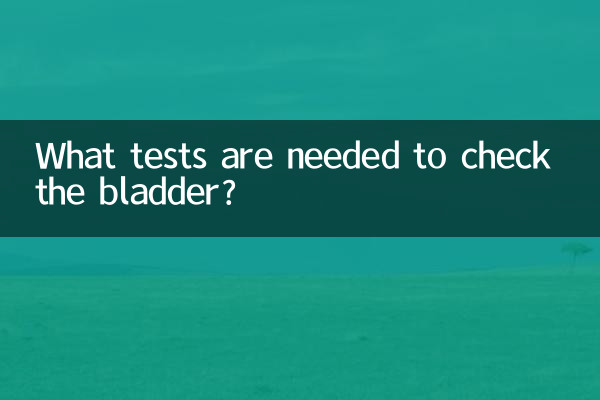What tests are needed to check the bladder?
The bladder is an important organ of the human urinary system, and its health directly affects urinary function and overall quality of life. Your doctor may recommend a bladder exam when you experience symptoms such as frequent urination, urgency, painful urination, or hematuria. The following is the bladder examination-related content that has been hotly discussed on the Internet in the past 10 days, as well as a detailed analysis of the examination items.
1. Common reasons for bladder examination

Bladder exams are often triggered by the following symptoms or conditions:
| symptoms/disease | Possibly associated bladder problems |
|---|---|
| Frequent urination and urgency | Cystitis, overactive bladder |
| hematuria | Bladder tumors and stones |
| Painful urination | infection, stones |
| urinary incontinence | Neurogenic bladder, muscle relaxation |
2. Main items of bladder examination
The following are commonly used clinical bladder examination methods and their uses:
| Check items | Check content | Applicable situations |
|---|---|---|
| Routine urine examination | Analyze red blood cells, white blood cells, proteins, etc. in urine | Initial screening for infection and bleeding |
| Bladder ultrasound | Observe bladder morphology and capacity through ultrasound | Stones, tumors, residual urine output |
| Cystoscopy | An endoscope looks directly inside the bladder | Tumors, ulcers, foreign bodies |
| Urodynamic test | Assess bladder storage and voiding function | Urinary incontinence, difficulty urinating |
| CT/MRI | 3D imaging showing the bladder and surrounding tissue | Tumor staging, complex lesions |
3. Hot topics: Precautions for cystoscopy
Recently, many patients have shared their cystoscopy experiences on social platforms. The following are summarized notes:
1.Preparation before inspection: Usually the bladder needs to be emptied, and in some cases a cleansing enema may be required in advance.
2.Check process: Local anesthesia will be used and there may be slight discomfort, but most people can tolerate it.
3.Post-examination care: It is recommended to drink more water. Temporary hematuria may occur, which is normal.
4. Comparison of the advantages and disadvantages of different inspection items
| Check type | advantage | shortcoming |
|---|---|---|
| Ultrasound examination | Non-invasive, no radiation, low price | Unable to see details inside the bladder |
| Cystoscopy | Intuitive, biopsies can be taken at the same time | Invasive, may be uncomfortable |
| CT examination | Show surrounding organizational relationships | There is radiation and the cost is higher |
5. How to choose inspection items?
The doctor will recommend a test plan based on the severity of the symptoms, the type of suspected disease, and the patient's individual circumstances:
•initial screening: Usually starts with urine routine and ultrasound
•suspected tumor: Requires cystoscopy + biopsy
•functional assessment: Urodynamic examination is more appropriate
6. Latest inspection technology progress
Two new technologies for bladder examination were recently reported in medical journals:
1.Fluorescence cystoscopy: Using special dyes to improve tumor detection rates
2.virtual cystoscopy: Non-invasive examination through CT three-dimensional reconstruction
7. Recommendations for preventing bladder diseases
According to recent health science content, you should pay attention to maintaining bladder health:
• Keep the daily water intake at 1500-2000ml
• Avoid holding urine for long periods of time
• Pay attention to personal hygiene and prevent urinary tract infections
• People over 40 years old are recommended to have a urinary system examination once a year
Through the above structured information, patients can comprehensively understand the relevant knowledge of bladder examination. Please be sure to follow your doctor's instructions for the actual examination plan and make it based on individual circumstances.

check the details

check the details